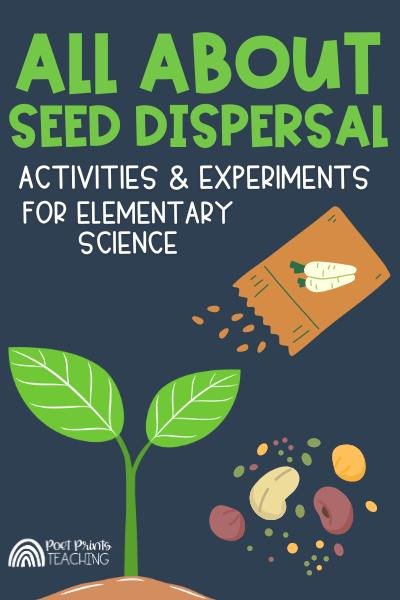How Seeds Disperse - Elementary Science Activities
Have you ever seen a chipmunk running around with food in its cheeks? Or come upon a buried stash of acorns? These are not just fun discoveries, they are examples of seed dispersal in action! Teaching students about how seeds are dispersed is such a fun science topic, and there are some interesting/interactive ways to teach how seeds spread.
All About Seed Dispersal: Activities and Experiments for Elementary Science
How do seeds disperse?
Let’s take a quick look at what seed dispersal is. Essentially, seed dispersal is the way that seeds spread around so plants can grow in new areas. Without seed dispersal, plants would be stuck growing in the same place season after season and the seeds would also be competing with each other for the resources needed to survive. Seed dispersal allows plants to find new locations to grow and thrive.
seed dispersal examples
There are five main ways that seeds spread: animals, wind, water, explosion, and fire. Here are a few examples:
Seeds get stuck on a dog’s fur and as the dog walks around, the seeds drop into new areas.
Seeds get eaten by a bird. The bird flies away and…how do I put this delicately?...poops on something. There are seeds in the bird’s droppings and the seeds grow in a new location.
Have you ever heard the term “squirrel away”? Well, squirrels store food for the winter and often bury a cache of seeds and nuts, which can lead to plants growing in new areas.
The wind carries seeds to new locations
Water lilies and coconuts rely on water to spread their seeds.
Eucalyptus plants have seeds with a protective layer that needs to be melted away by fire before it can grow.
And some plants, like violets, will eject seeds to disperse them.
Seed Dispersal YouTube Videos
Videos are a great way to create excitement when introducing a new topic, and YouTube has a handful of really great ones about seed dispersal. Youtube videos.
Here are some fun videos about how seeds spread:
This SciShow Kids video introduces students to the question “How do Plant Seeds Travel?” The video also shows the structure of seeds and how this helps seeds spread. For example, burs have little hooks on them which allows these seeds to stick to animal fur.
This is a fantastic video of Maddie who explores the forest searching for seeds. She also explains how seeds get spread.
This is a short one minute video that gives a quick overview. It doesn’t give all the ways for seed dispersal, but it’s a good start if you’re looking for something super quick.
Want to show seed explosion? This video from the Smithsonian shows a great time-lapse of seed dispersal by explosion.
Teach All About Seed Dispersal
Looking for a FAST way to teach about seed dispersal that includes nonfiction reading and a STEM challenge? In just a few clicks you can grab all of the pieces you need: lesson plans, informational text, reading comprehension, and a fun STEM challenge.
Click and print. Planning is really that easy.
Nonfiction reading and worksheets
Using nonfiction reading in a science class is a great way to meet multiple standards in the same lesson!
In this STEM and Reading lesson set, students read a passage entitled “How Did That Grow There?” Afterward, students complete a worksheet about what they read. This not only helps to develop comprehension skills, but it also allows them to solidify the information they just read.
Then I have students create a comic that shows a seed’s journey to a new location using one of the seed dispersal methods from the passage (I took this word for word from the project description…). This gives students a creative outlet for deepening their knowledge!
Need to differentiate? I have a 2nd set of nonfiction reading passages about seed dispersal that comes in two text levels AND two comprehension levels. It’s easy to mix and match to make the assignment work for your class.
seed dispersal stem challenge
Getting hands-on with a STEM challenge is one of the best ways to explore how seeds spread. In this activity, students will create a seed dispersal device.
Using miscellaneous crafting supplies like egg cartons, pipe cleaners, and rubber bands, students will be tasked with creating a device that will spread seeds over a distance (not just dump them in a single location).
Make sure to allow students time to plan and test their devices as well. Not only does this activity teach students about seed dispersal, but it also allows them to practice other skills like design, cooperation, communication, and revising.
float vs. fly
For another hands-on activity, try conducting an experiment about which seeds float and fly. Give your students a variety of seeds. Have stations set up with straws and bowls of water. Students can use the straw to blow the seeds to see which will fly away and they can place the seeds in the water to see which seeds will float.
Take a neighborhood walk
If you’re looking to get out in nature and your students are prepared to get a little dirty, you can do a nature walk. However, before going, give students socks to slip over their shoes. Then have students walk around. When you’ve completed the walk, have students remove the socks and check out what might be attached. Maybe they will find some seeds on the socks!
These are just a few activities to teach how seeds spread. The topic of seed dispersal can be engaging and exciting. It’s a necessary part of nature and we have the privilege of helping out students marvel at the wonder of this natural phenomenon.
Pin me for later!
Lessons about how seeds are dispersed for elementary science. Picture: a chipmunk sits on top of a sunflower with cheeks full of seeds.




